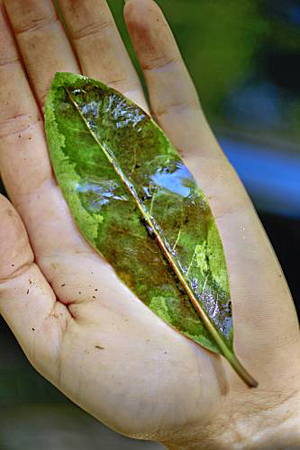By: Peter Fimrite, Chronicle Staff Writer

Scientists have discovered an oak tree in the Presidio with the tree-killing disease known as sudden oak death, only the second time the fast-spreading pathogen has been found in San Francisco.
The coast live oak tree on the southeastern edge of the national park was believed to have been infected by an ornamental plant in the garden of one of several nearby homes, said Matteo Garbelotto, the head of UC Berkeley's Forest Pathology and Mycology Laboratory.
It is a troubling find, he said, because it means the microbe escaped and infected a wild tree despite an intensive nationwide effort to control the disease in nurseries.
"Normally it spreads a maximum of a few hundred yards, so I would say the likely source of this is not too far away," Garbelotto said.
The find is "a concern in California but also in all the other states," he said, "because it shows that, despite the regulations, lingering - even low-level - infection may still infect oaks in the wild."
Rare native
The infected oak, near West Pacific Avenue and not far from Julius Kahn Playground, is one of the few native trees in the Presidio. The 300-acre park, which has 60,000 trees, contains only about 200 oaks, all of which grew naturally from acorns native to San Francisco.
The infection was spotted in October by an arborist for the Presidio Trust, which manages the interior 80 percent of the park for the Golden Gate National Recreation Area.
Garbelotto's laboratory took samples, which showed a strain of sudden oak death that is normally seen only in ornamental plants.
Laboratory workers then tested all the other trees in the area, including four other oaks and some 50 plants, including toyon, the only wild species nearby that can carry and spread the deadly microbe. Soil samples were also taken, but no evidence of the pathogen was found anywhere else.
One logical source
The only logical sources for the infection, Garbelotto said, are the many large gardens at the upscale homes next to the Presidio. The gardens have not been tested, but a public information campaign has been started and the Presidio Trust is encouraging neighbors to bring in samples of ornamental plants.
Sudden oak death, discovered in Mill Valley in 1995, exists in forests and wildlands in 14 California counties and in Curry County, Ore. It kills oak trees, especially tan oaks, which have nearly been wiped out in portions of Big Sur, Sonoma Mountain, Jack London State Park, China Camp State Park and Marin Municipal Water District watershed lands near Mount Tamalpais.
The disease, known scientifically as Phytophthora ramorum, also has 107 susceptible host plants, including such common garden ornamentals as camellias and rhododendrons. Most hosts survive, but they help spread the disease to oaks.
Researchers have found that infected California bay laurels are the most effective spreaders of the pathogen's spores.
90 percent die-off
Arborists and ecologists are afraid that sudden oak death could eventually denude California's golden hills of its signature tree. As it is, experts predict that as many as 90 percent of California's live oaks and black oaks could die within 25 years.
One good thing about the recent find, Garbelotto said, is that there are no bay laurels in the area and the pathogen cannot spread from a standing oak tree.
Garbelotto said he believes the tree was infected in 2006. He said oak infections usually take hold during heavy spring rains, which occurred last year and in 2006. The pathogen wouldn't have shown up yet if the tree had been infected a year ago.
The only other San Francisco infection occurred several years ago near the AIDS Memorial Grove in Golden Gate Park. That tree was near bay laurels and ornamental rhododendrons, Garbelotto said.
The second time
It is only the second time the disease has been found in a national park. Infected trees were also found in Redwood National Park last year.
However it got in the Presidio, Garbelotto said, the new infection should serve as a wake-up call across the United States.
"People's ears should go up in states where they have it in nurseries but not in the wild," he said. "It shows that it can escape."
Read it at the source
